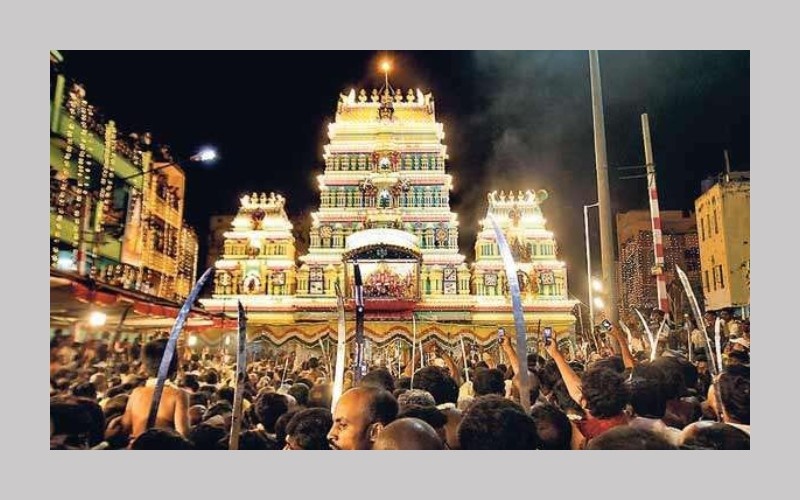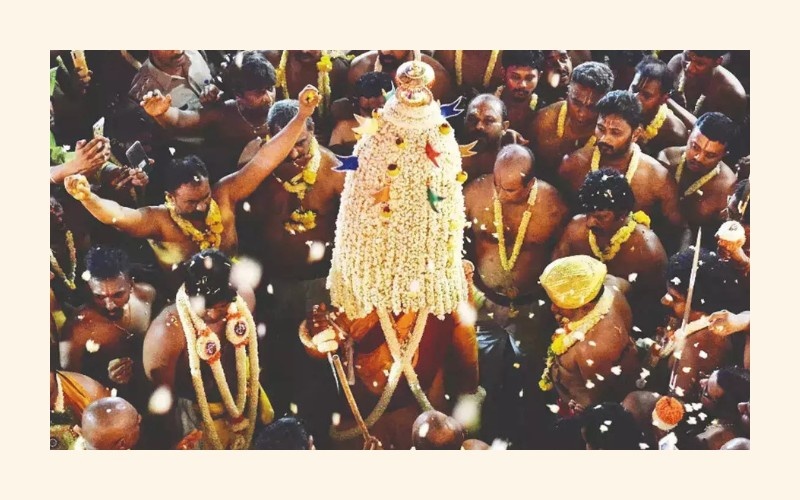The Bangalore Karaga stands as the city’s longest-running festival which keeps ties to mythical stories and cultural customs as well as social connections. The Thigala community has recognized Draupadi as the central figure of the Karaga festival for many consecutive centuries. Every year during the month of March to April Draupadi receives veneration through a magnificent nighttime procession which controls the heart of Bengaluru while symbolizing her traits of strength and virtue and resilience.
The History
According to tradition the ancient Karaga celebration has roots which extend back to the Mahabharata through the story of Draupadi. The literary text presents Draupadi as an incarnation of Shakti which stands as the absolute female power of creation. Local people believe that after the Mahabharata war Draupadi accepted a request from her warrior devotees named Veerakumaras to stay on Earth to defend dharma. People believe that her annual visit is marked by the Karaga festival.
Through its performance the festival brings more than traditional jubilation because it restages Draupadi’s divine return to bestow blessings upon her followers about their everlasting pledge to preserve justice and display courage.
Historical Evolution
History traces the mythological origins of Karaga far across time but its formal celebration in Bengaluru started approximately hundreds of years ago. A Tamil-speaking group of horticulturists named Thigalas maintains ritual leadership over this tradition since settling under Vijayanagara Empire rule into the region.
According to historical records the tradition dates back 800 years to worship at Dharamaraya Swamy Temple in Nagarathpet as its spiritual epicentre. The temple has existed for almost five centuries while the devotion to Draupadi and the Pandavas by the community continues to maintain a connection with Bangalore’s cultural and devotional aspects.
The Rituals and Festivities
- Day 1 – Dwajarohana (Flag Hoisting):
The religious gathering begins when the dignified flag receives its traditional ascent at the Dharmaraya Swamy Temple. Under this auspicious gesture the Karaga festival formally begins while summoning the divine presence of Draupadi. - Day 2 – Temple Rituals and Vows:
The temple grounds escalate the intensity of religious activities. The Karaga priest and Veerakumaras start their fasting period through a strict vow that demands adherence to complete discipline and adherence to purity laws. - Day 3 – Hasi Karaga (Green Karaga):
During this event a small procession uses the sacred container as a centerpiece to initiate the upcoming main ritual. The first appearance of Draupadi’s energetic power occurs at this time. - Days 4–9 – Daily Rituals and Community Visits:
These days serve a dual purpose which includes spiritual purification services combined with storytelling activities and community feasting as well as temple ceremonies. The priest conducts his transformation through spiritual practices in seclusion. - Day 10 – Main Karaga Procession (Full Moon Night):
The Karaga bearer performs as Draupadi during this most expected night while taking the holy flower pot along a night-time 18-km route. - Day 11 – Completion and Farewell Rituals:
The temple receives the Karaga festival parade which is followed by prayers. During the final phase of the festival the priest removes his ceremonial clothes before completing thanksgiving ceremonies along with symbolic farewell customs.

The Karaga Bearer: The Living Vessel of Draupadi’s Spirit
Bangalore Karaga festival centers around a figure who receives deep respect and follows strict codes along with being a symbol of great meaning—the Karaga bearer designated as Karaga priest. According to Thigala community traditions the selected person embodies Draupadi in the procession without being an administrative leader but a spiritual entity. One of the most significant religious acts in the festival occurs when the ordinary man transforms into the divine embodiment of the feminine.
Selection and Spiritual Preparation
The selection method for Karaga bearers follows strict guidelines. The selection depends on three main criteria: community position together with ancestral lineage and most importantly the ability to perform strict spiritual practices and physical efforts. The chosen bearer must follow vrata (vow) discipline for 11 days to fulfill the rules.
- The Karaga bearer follows celibacy as well as strict austerities to abstain from any sensual activities.
- The Karaga bearer consumes exclusively satvik vegetarian food during his daily routine which involves single daily meals.
- A bearer conducts daily ritual bathing and takes part in multiple ceremonies at the temple.
- Sleeps on the floor without any comfort, as a sign of humility and purification.
Through this practice the devotee trains both mind and body to welcome Devi Draupadi’s shakti which is believed to manifest on the main procession night.
The Moment of Transformation
During the main evening of Karaga the ritual priest completes a holy metamorphosis. The priest transforms into a female appearance by wearing a yellow saree with blouse and bangles while placing jasmine flowers in his hair. The sacred ritual serves as a transformation which symbolizes full devotion to the goddess through the priest.
The remarkable aspect rests in how females and males align their energies throughout the event. They show their commitment to divine femininity through this spiritual journey even though he maintains his biological gender of male. The transformation creates a sacred connection whereby the priest experiences a spiritual event which aligns with the Hindu belief of the combined Shiva-Shakti divine form known as Ardhanarishvara.
Carrying the Karaga
The Karaga constitutes a holy mud pot that receives decoration from a flower pyramid of jasmine blooms and turmeric substances and neem leaves together with other holy elements. A few elderly members in the community maintain exclusive knowledge about what resides within this mystical object. Due to its extraordinary nature the pot travels solely on the priest’s head without any external support systems and without using hands or any supporting equipment.
A Nagarakuteera priest walks the entire 18 kilometer distance while barefoot among thousands of Bangalore city residents and their procession of dancers, drummers and bearers. The Karaga has to remain upright at all times while the priest continues his unbroken path through the disorder.
Community legend states that a spiritual imbalance will occur when the Karaga falls or if the priest breaks their continuous journey. The priest requires the continual presence of Veerakumaras who carry swords because he experiences overwhelming pressure during the procession.
Veerakumaras and the Covenant of Protection
Veerakumaras perform duties beyond their religious role as ceremonial royal guards. From the traditional perspective the Karaga bearer faced death as punishment from the Veerakumaras if they either disrupted or mistreated the ritual. Modern symbolism aside the demanding religious duties which the sacred bearer must execute demonstrate how serious the responsibility actually is.
The male guards walk together through the crowd as the performers chant and fight with their swords to maintain an open path. They continue to protect while maintaining responsibility through their presence which symbolizes the divine-community relation established through sacred contracts.
A Personal Journey of Transformation
These public demonstrations serve as a profound spiritual path for the Karaga bearer. The bearers experience feeling “possessed” and “guided” by an invisible force during the procession which makes them act as a spiritual conduit for the goddess to descend. Following the festival period the bearer returns to regular life although they maintain selected spiritual practices during the entire year.
The position transforms into a continuous spiritual connection which brings honor to previous Karaga wearers who remain respected by their community throughout their lifetime.
A Ritual of Inclusivity
The Bangalore Karaga festival embodies exceptional interfaith unity by maintaining a long tradition of association with the revered Sufi shrine Hazrat Tawakkal Mastan Dargah located in Cottonpet.
Historical Tradition Rooted in Harmony
The dargah holds special significance during Karaga rituals when the priest pauses at this sacred site to show reverence through heartfelt worship ceremonies. This practice continues today as a living tradition which demonstrates over 100 years of Bangalore’s history where Hindus and Muslims maintain peaceful relations.
Built in the 18th century by Hyder Ali then finished by Tipu Sultan in 1783 this dargah serves to honor Hazrat Tawakkal Mastan Baba who was a Sufi saint from the Suharwardia order. People of various religious backgrounds continue to view the site as a fundamental symbol of religious unity so devotees throughout multiple creeds consider the Karaga’s annual pilgrimage to this location as one of their primary spiritual experiences.
Legend of the Saint and the Kumkum
Local folklore narrates that Hazrat Tawakkal Mastan Baba received injuries from trampling during the initial Karaga procession. Hindu priests used kumkum to dress his injuries which led to his remarkable recovery. The grateful saint received a promise from the procession organizers to return every year which they have kept consistently since that time.
The story reports that the saint received a vision of Draupadi while making a vow to safeguard both the Karaga and its performer. Each year the Karaga priest makes a stop at the dargah during his midnight procession to pray while receiving blessings through musical songs performed by traditional Muslim devotees who are accompanied by cheering spectators from various communities of people.
Karaga as a Living Heritage
The Bangalore Karaga presents itself through multiple dimensions as both a sacred religious expression and a traditional heritage which continues to evolve. This celebration merges historical events with tradition as well as religious devotion with passionate worship and faith with broad social participation. Through its timeless practice the Karaga shows modern society that traditional customs offer lessons about honorable survival along with sympathetic caring and human uniting.
During the Bangalore Karaga participants put their souls into the ceremony by displaying jasmine scents with sword weapons alongside endless prayers while uniting under one roof bringing forth the heart and spirit of Bangalore.














